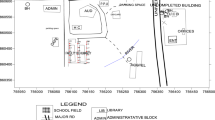Abstract
An integration of geophysical methods including electrical resistivity and seismic refraction was used to investigate the possible causes of the cracks observed on some buildings at Edunabon, southwestern Nigeria. A total of three 2D electrical resistivity imaging (ERI) traverses and eight vertical electrical sounding (VES) were acquired using dipole–dipole and Schlumberger electrode configurations, respectively. The 2D ERI and VES data were processed and inverted to obtain the subsurface models. Seismic refraction data were also acquired along eight traverses using a 24-channel ABEM seismograph with geophone spread of 2 m, and integrated with electrical resistivity data, to adequately delineate the geomaterials responsible for the localized structural defects in the area. The results of electrical resistivity method revealed four geoelectric layers including topsoil, clayey material, weathered basement and fractured/fresh basement. However, the geosection models of seismic refraction revealed two geophysical layers (overburden and basement bedrock) with characteristics that corroborate the electrical resistivity results. The overburden has an average velocity and thickness of 405 m/s and 7.1 m, respectively, which is diagnostic of weak/unconsolidated materials, presumably clayey material. The integrated results revealed that the observed cracks on the buildings may be due to the foundation soil that is composed of incompetent materials (clayey materials) which may compress under differential effective stress. This study shows that the integration of geophysical methods can identify the causes of the differential subsidence of engineering structures.









Similar content being viewed by others
Availability of data and material
Data and material could be provided upon request.
References
Adukwu G, Fadele IS (2012) Relevance of Geophysics to Foundation Studies. Department of Physics and Astronomy (solid Earth Geophysics Option), University of Nigeria
Alisiobi AR, Ako BD (2012) Groundwater investigation using combined geophysical methods. In: AAPG annual convention poster presentation.
Cardarelli E, Cercato M, De Donno G, Di Filippo G (2014) Detection and imaging of piping sinkholes by integrated geophysical methods. Near Surf Geophys 12:439–450. https://doi.org/10.3997/1873-0604.2013051
Coker JO, Makinde V, Mustapha AO, Adesodun JK (2013) The application of geophysical methods in foundation failure investigation a case study of metro hostel, camp area, Abeokuta, South Western Nigeria. Nat Sci 11(11):103–109
Cosenza P, Marmet E, Rejiba F, Jun Cui Y, Tabbagh A, Charlery Y (2006) Correlations between geotechnical and electrical data: a case study at Garchy in France. J Appl Geophys 60:165–178
Egwuonwu GN, Osazuwa IB (2011) Geophysical and geotechnical investigation of the origin of structural instabilities shown on some low rise buildings in Zaria, northwestern Nigeria. Pac J Sci Tech 12(2):534–547
Fajana AO (2020) Geohazard characterization of subsurface materials using integrated geophysical methods for post foundation studies: a case study. Model Earth Syst Environ. https://doi.org/10.1007/s40808-020-00861-3
Fatoba JO, Fajana AO, Folorunso ASO (2017) Seismic refraction and electrical resistivity investigation of building failure: a case study. FUOYE J Eng Technol 2(1):106–109
Khalil MH, Hanafy SM (2008) Engineering applications of seismic refraction method: a field example at Wadi Wardan, Northeast Gulf of Suez, Sinai, Egypt. J Appl Geophys 65(3–4):132–141. https://doi.org/10.1016/j.jappgeo.2008.06.003
Neil A, Ahmed I (2006) A generalized protocol for selecting appropriate geophysical techniques. Department of Geology and Geophysics, University of Missouri, Rolla, p 19
Nigerian Geological Survey Agency (NGSA) (2004) Topographical Map of Ibadan. Published by the authority of the Federal Republic of Nigeria.
Odeyemi SO, Giwa ZT, Abdulwahab R (2019) Building collapse in Nigeria (2009–2019), causes and remedies—a review. USEP J Sci Eng Prod 1(1):122–135
Oke A (2011) An examination of the causes and effects of building collapse in Nigeria. J Des Built Environ 9:37–47
Oladunjoye MA, Salami AJ, Aizebeokhai AP, Sanuade OA, Kaka SI (2017) Preliminary geotechnical characterization of a site in Southwest Nigeria using integrated electrical and seismic methods. J Geol Soc India 89(2):209–215. https://doi.org/10.1007/s12594-017-0585-z
Osella A, Martinelli P, Grunhut V, de la Vega M, Bonomo N, Weissel M (2015) Electrical imaging for localizing historical tunnels at an urban environment. J Geophys Eng 12:674–685. https://doi.org/10.1088/1742-2132/12/4/674
Oyedele KF, Oladele S, Adedoyin O (2009) Application of Geophysical and Geotechnical Methods to Site Characterization for Construction Purposes at Ikoyi, Lagos, Nigeria. J Earth Sci Geotech Eng 1(1):87–100
Oyeyemi KD, Aizebeokhai AP, Adagunodo TA, Olofinnade OM, Sanuade OA, Olaojo AA (2017) Subsoil characterization using geoelectrical and geotechnical investigations: Implications for foundation studies. Int J Civ Eng Technol 8(10):302–314
Oyeyemi KD, Olofinnade OM, Aizebeokhai AP, Sanuade OA, Oladunjoye MA, Ede AN, Adagunodo TA, Ayara WA (2020) Geoengineering site characterization for foundation integrity assessment. Cogent Eng 7:1711684
Paasche H, Rumpf M, Hausmann J, Fechner T, Werban U, Tronicke J, Dietrich P (2013) Advances in acquisition and processing of near-surface seismic tomographic data for geotechnical site assessment. First Break 31(8):59–65
Rahaman MA (1976) Review of the basement geology of South-Western Nigeria. In: Kogbe CA (ed) Geology of Nigeria, 2nd edn. Elizabethan Publishers, Lagos, pp 41–58
Whiteley JS, Chambers JE, Uhlemann S, Wilkinson PB, Kendall JM (2019) Geophysical monitoring of moisture-induced landslides: a review. Rev Geophys 57:106–145. https://doi.org/10.1029/2018RG000603
Acknowledgements
The authors would like to acknowledge the Boone Pickens School of Geology at Oklahoma State University, Stillwater USA for the provision of valuable software.
Funding
The author did not receive funding from any individual or organizations.
Author information
Authors and Affiliations
Corresponding author
Ethics declarations
Conflict of interest
The authors declare that there is no conflict of interest.
Additional information
Publisher's Note
Springer Nature remains neutral with regard to jurisdictional claims in published maps and institutional affiliations.
Rights and permissions
About this article
Cite this article
Akinbiyi, O.A., Sanuade, O.A., Akanji, A.O. et al. An integrated geophysical approach for post foundation studies at Edunabon town, southwestern Nigeria. Model. Earth Syst. Environ. 7, 1281–1289 (2021). https://doi.org/10.1007/s40808-020-01001-7
Received:
Accepted:
Published:
Issue Date:
DOI: https://doi.org/10.1007/s40808-020-01001-7




